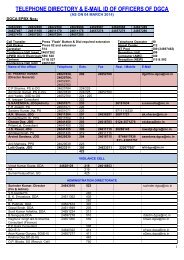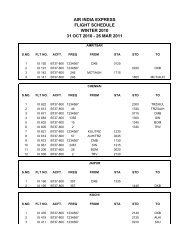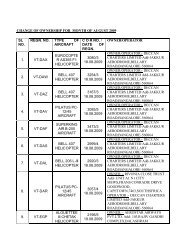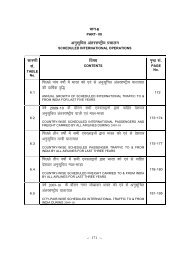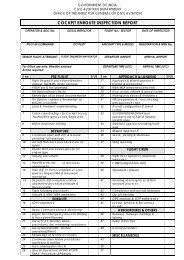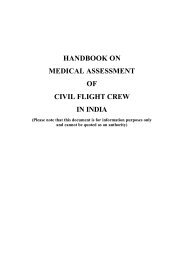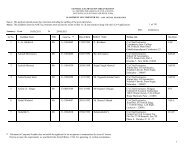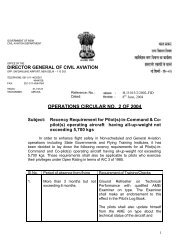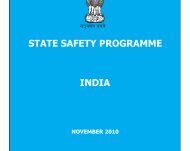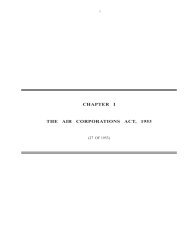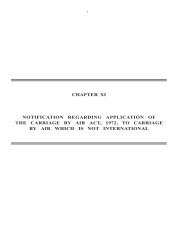Aerodrome Advisory Circular 1 of 2011 - Directorate General Civil ...
Aerodrome Advisory Circular 1 of 2011 - Directorate General Civil ...
Aerodrome Advisory Circular 1 of 2011 - Directorate General Civil ...
Create successful ePaper yourself
Turn your PDF publications into a flip-book with our unique Google optimized e-Paper software.
GOVERNMENT OF INDIAOFFICE OF DIRECTOR GENERAL OF CIVIL AVIATIONTECHNICAL CENTRE, OPP SAFDARJANG AIRPORT,NEW DELHI<strong>Advisory</strong> <strong>Circular</strong> No. 01/<strong>2011</strong> dated 8 th March <strong>2011</strong>Operational Safety Competenciesfor <strong>Aerodrome</strong> Operators
ContentsExplanatory NoteIntroductionPurposeTerminologyApplicationChapter 1Areas <strong>of</strong> Competence at senior level above line management, includingcorporate level when there is an element <strong>of</strong> accountability in provisionand service that may have an impact on securing safety <strong>of</strong> aircraft usingthe airport1. Legal Framework for <strong>Aerodrome</strong> Licensing2. Management Competence - Senior OperationsManagement3. <strong>Aerodrome</strong> Safety Management Systems3a. Safety Risk Management as an element <strong>of</strong> <strong>Aerodrome</strong> SafetyManagement System3b. Change Management as an element <strong>of</strong> <strong>Aerodrome</strong> SafetyManagement SystemChapter 2Areas <strong>of</strong> competence at line management and middle/supervisory levels,where appropriate, including shift and project managers and thoseresponsible for outsourcing or supervising contractors for safety-criticalservices4. Legal Framework for <strong>Aerodrome</strong> Licensing5. Management Competence – Line Level Management6. Safety Management Systems, including Safety risk managementand change management7. Management and Operation <strong>of</strong> the Airport Operations ControlCentre (AOCC)8. <strong>Aerodrome</strong> Physical characteristics - movement area statusand condition9. Surface Movement and Guidance System (SMGCS), visual aidsfor approaches, and Electrical Systemsi
10. Airfield Work in Progress11. <strong>Aerodrome</strong> Zoning/Safeguarding - obstacle and wildlife habitatcontrol aspects on and around <strong>Aerodrome</strong>s12. Apron Management and Operations13. Airside Vehicle Operations14. Runway Surface Friction15. Runway Contamination16. Wildlife Hazard Control17. Aeronautical Information Systems18. Low Visibility and Night Operations19. Fire and Rescue Operations20. Handling <strong>of</strong> fuel and Hazardous Materials21. <strong>Aerodrome</strong> Emergency Plan and Procedures22. Airport Security Provisions23. Cargo OperationsChapter 3.The chapter is formulated for aerodrome Licensee to provide guidelinesin framing the organogram for inclusion in the <strong>Aerodrome</strong> Manual.ii
Explanatory Note to this versionThis advisory circular is a living document and will be revised at intervals to takeaccount <strong>of</strong> changes in regulations, feedback from industry, and recognised bestpractices to facilitate the license holder to demonstrate compliance in terms <strong>of</strong>manpower deployed for aerodrome operation.iii
IntroductionIn recent years, the management <strong>of</strong> risks to safety has taken a significantevolutionary step, with safety management having a focus at the organisational andsystems level, with greater attention to the interfaces between the various elements <strong>of</strong>the overall aviation system, including the human being.ICAO Standards for State adoption have been developed for SafetyManagement Systems, and the DGCA is in the process <strong>of</strong> meeting its obligations inthat regard with recent and evolving <strong>Civil</strong> Aviation Regulations (CARs) for Indianairports. These CARs include the need for service providers to confirm anddemonstrate their organisational competence; CAR Series F Section 4 refers (staffestablishment/competency).The DGCA recognizes that regulations which bring significant change cangenerate the need for complimentary guidance material. Consequently, the<strong>Aerodrome</strong> Standards <strong>Directorate</strong> <strong>of</strong> the <strong>Directorate</strong> <strong>General</strong> <strong>of</strong> <strong>Civil</strong> Aviation (DGCA)India has developed this <strong>Circular</strong>. It is designed to assist Licensees in satisfyingthemselves, in the first instance, <strong>of</strong> their organisational competence, using ananalysis <strong>of</strong> staffing establishment, qualification and experience needs, against theoperational objectives, requirements and tasks, for all safety-critical functional areas.This is in addition to the provision <strong>of</strong> appropriate infrastructure, equipment andtechnical and management systems, in line with DGCA CARs. Whilst the DGCAmay consider alternative means <strong>of</strong> complying with the competence element <strong>of</strong> theSeries F CAR, those means would have to give firm evidence <strong>of</strong> organisationalcompetence to the same degree, and as identifiable as that detailed in this AD AC.The advent <strong>of</strong> privatisation and the consequent commercially orientedapproach to the management <strong>of</strong> licensed aerodromes has the potential to createsignificant change. Business driven objectives have assumed a higher priority andmanagement structures and skills have shifted towards a more business focusedculture. Change, even when beneficial, can be a generator <strong>of</strong> hazards which may bespecific or common to aerodromes.The practice <strong>of</strong> granting licenses to corporate bodies, with major decisionmaking being held at corporate level rather than to individual airportcompanies/management, which is not in line with general accepted practice, will haveits own hazard generators. For example, if there is a practice <strong>of</strong> transferring staffbetween airports on a frequent and short-notice basis.These changes place an even greater emphasis on the Airport Licensee, theAccountable Executive at the airport, and senior management understanding theiraccountabilities and responsibilities in managing safety at their airports in asystematic and organised manner. Also, on the need for them to be able to giveassurances, as part <strong>of</strong> those accountabilities and responsibilities, to the DGCA andothers about their organisation’s capability and competence in securing the safety <strong>of</strong>operations at their airport, including:(a)(b)The necessary level <strong>of</strong> knowledge and understanding <strong>of</strong> safetymanagement principles at the highest level <strong>of</strong> senior management, aswell as at the more traditional line levels.The transparent establishment <strong>of</strong> staff numbers through the use <strong>of</strong>1
management tools, such as task analysis, for all safety-critical areas,including those contracted out.(c)The capability to demonstrate to external as well as internal auditors,that staff establishment is continually being monitored, using internalmanagement systems. Furthermore, that the establishment is adjustedto suit any increase in air traffic and safety demands placed on theorganisation.The DGCA will expect evidence <strong>of</strong> this to be available during the issue <strong>of</strong> initiallicense as well as during planned and ad-hoc surveillance inspections, includingsafety assurance for any significant change. One way <strong>of</strong> showing staff establishmentnumbers is to:(a)(b)Construct an organogram with the numbers <strong>of</strong> safety critical staffindicated; andFor this to be continually reviewed and updated.By ensuring that the appropriate knowledge and understanding is present at alllevels in an organisation there will be a greater probability <strong>of</strong>:Purpose• Providing stable and sustained organisational competence;• Ensuring improvements in safety performance;• Preventing any reduction in the priority attached to safety; and• Providing the necessary skills sets available in aviation operations atexecutive management level, as well as the line and lower levels.The aim <strong>of</strong> this document is to enable licensees to assess the level <strong>of</strong> operationalsafety management competence existing within their respective airport organisations,including any areas that are contracted out, and to ensure that they have the necessaryexpertise at the appropriate level to formulate and implement systems to adequatelymanage safety.Therefore, it addresses tasks at the senior to supervisory level in two Chapters,chapter 1 aimed at the senior management level and Chapter 2 at the line to supervisorylevel. It does not cover tasks at the “operative” level. However, licensees are encouragedto adapt and apply the material for this purpose; it is intended as a management tool to beused by licensees and their airport managements for internal use, not only as amechanism to satisfy the safety regulator. It should be noted that most <strong>of</strong> the topic areascovered by this document are subject to specific safety regulation by the DGCA, butlicensees may wish to extend the principle to other areas for their own managerialpurposes.As recognized above, some tasks within the competences and some topic areasmay be ‘contracted out’ by the aerodrome licensee. Whilst day-to-day operationalmanagement is the responsibility <strong>of</strong> such a contractor, the aerodrome licensee continuesto have overall accountability and responsibility for the safe integration <strong>of</strong> contractedactivities with the rest <strong>of</strong> the aerodrome operation. A licensee, therefore, needs to ensurethat competence and safety management requirements are included in contractspecifications and documents, including those relating to:2
This material:• The maintenance <strong>of</strong> determined and declared staff/operative numbers;• Safety performance; and• Appropriate supervision, monitoring and follow-up.1. Takes account <strong>of</strong> the need to accommodate a range <strong>of</strong> licensed aerodromes andtheir varied scope <strong>of</strong> operations. Not all <strong>of</strong> the tasks listed will be appropriate ornecessary for all aerodromes, an issue <strong>of</strong> particular interest to the smalleraerodromes. Not all <strong>of</strong> the areas <strong>of</strong> competence have to be vested in one person,an issue <strong>of</strong> particular interest to the larger aerodromes.2. Will assist the aerodrome licensee to:(a)(b)Identify the post/s and person/s that have accountabilities and/orresponsibility for a specific task, including project managers, shiftsupervisors and those monitoring the safety performance <strong>of</strong> contracted-outservices;Be satisfied that persons within the management structure possess therelevant operational safety competence, or identify gaps and, therefore,training needs, that may exist in specific areas <strong>of</strong> competence;(c) Develop job specifications, training programmes, recruitment andsuccession planning; and(d)Provide, for aerodrome licensing purposes, the safety assurance soughtby the DGCA on operational safety competence <strong>of</strong> the licensee’sorganisation.TerminologyFor ease <strong>of</strong> interpretation, several key terms used throughout this document aredefined as follows:Background Knowledge – The collective body <strong>of</strong> information and skill sets, gainedthrough experience and training, that people need to have, if they are to perform theirroles competently. This includes memorised relevant facts, regulations, theories andprinciples, and knowing where to find such data when it is not necessary to commit themto memory.Ensure – The dictionary meaning implies 100% guarantee, and this is theobjective. It may be argued that an interpretation may at times be like safety risksbeing reduced to As Low As Reasonably Practicable (ALARP). However, thatcannot and must not be an excuse for not making all reasonable efforts to “ensure”to the dictionary definition where possible.Hazard – A condition or an object with the potential to cause injuries to personnel,damage to equipment or structures, loss <strong>of</strong> material, or reduction <strong>of</strong> ability to performa prescribed function (ICAO 9859, Edition 2).3
Infrastructure project - A building or structure (defined as arrangement <strong>of</strong> parts).This could be a new or upgrade <strong>of</strong> facilities, a replacement or refurbishment <strong>of</strong> anexisting facility or a major maintenance project that will cause operationaldisruption over a significant period <strong>of</strong> time. Such projects will have differentsignificance in different contexts. For example, in terms <strong>of</strong> obstacle limitationsurfaces height will be the significant element, whereas for wildlife managementthe significant element will be attractiveness to wildlife.Named Person – A person, identified by name, who currently holds a specified post.Organisational Competence – Demonstrable capability <strong>of</strong> the organisation tosecure the safety <strong>of</strong> aircraft using the airport, having regard to the provision <strong>of</strong>equipment, facilities, management systems, documentation and staff. The staffestablishment must be:• Sufficient in terms <strong>of</strong> numbers for each <strong>of</strong> the functional areas; and• Suitably qualified and experienced with the appropriate combination <strong>of</strong>skill-sets for the tasks expected <strong>of</strong> them.This applies equally to staff for functions that are outsourced; functions for whichthe licensee remains accountable, in terms <strong>of</strong> aerodrome licence obligations.Risk, specifically Safety Risk - A measure <strong>of</strong> the seriousness <strong>of</strong>, or “put a number”on, the consequences <strong>of</strong> hazards, expressed in terms <strong>of</strong> predicted probability andseverity, <strong>of</strong> the consequences <strong>of</strong> a hazard ((ICAO 9859, edition 2).Safety Assurance Report - A structured argument, supported by a body <strong>of</strong> evidencethat provides a compelling, understandable and valid case that change in asystem/sub-system meets the service providers risk acceptability and changemanagement criteria for a given application in a given operating environment. It ismore than risk management, or even a safety assessment, as it includes in its scopethe outcomes <strong>of</strong> activities and assurances required by the change managementprocess, such as testing prior to entry-into- service. Depending on the nature <strong>of</strong> theapplication and operating environment a safety case may meet the requirement for asafety assurance report.Specified Post – A post within an aerodrome management structure, which has beenidentified as having responsibility for the management <strong>of</strong> a specific safety related task.Where more than 1 post has responsibility for the task then all the posts and postholdersneed to be identified and reviewed against the background knowledge.Task – An area <strong>of</strong> work for which a defined competence is deemed necessary.ApplicationThe Accountable Executive at the aerodrome, as the person with overallaccountability for safety management, or an appropriately delegated person, shouldidentify which areas <strong>of</strong> competence and tasks are relevant to their aerodrome. To assistthat person a check list format has been developed throughout the document.4
The tasks listed in the areas <strong>of</strong> competence, appropriate to a particularaerodrome, are those that should be vested in a particular “specified post or posts” and“named person or persons” occupying that post/posts, and annotated in the documentagainst each relevant task.Furthermore, it is expected that the ‘named person or persons’ for each task willhave knowledge and understanding <strong>of</strong> the aerodrome management ’ s policies andsystems, appropriate to the task expected <strong>of</strong> them.This circular is issued with the aim to guide aerodrome operators to appointpersons for key positions with adequate knowledge and experience in the relevant field.Although not being applied now, depending on the experience gained in future withapplication <strong>of</strong> this circular, prior approval <strong>of</strong> licensing authority may be made mandatorybefore appointment <strong>of</strong> such persons.The DGCA, in partnership with industry, will review and amend this material in thelight <strong>of</strong> usage and experience.New Delhi8 th March <strong>2011</strong>Sd/-(J.S. Rawat)Joint Director <strong>General</strong>for Director <strong>General</strong> <strong>of</strong> <strong>Civil</strong> Aviation5
C h a p t e r 1Areas <strong>of</strong> Competence at senior level above line management,including corporate level when there is an element <strong>of</strong>accountability in provision and service that may have animpact on securing safety <strong>of</strong> aircraft using the airport1. Legal Framework for <strong>Aerodrome</strong> LicensingTasksEnsure a thorough understanding throughout theorganisation <strong>of</strong>:The Licensees’ accountability and responsibilities insecuring and managing safety at the airport.The DGCA ’ s statutory duties in licensing and safetyoversight <strong>of</strong> Indian aerodromes.Ensure that aerodrome licensing and license renewalrequirements are met, and that the aerodrome operates inaccordance with licence conditions and statutoryrequirements, including those related to non-compliances,exemptions and airport infrastructure projects.Ensure an understanding by the aerodrome management<strong>of</strong> the legal requirement for, and status <strong>of</strong> the <strong>Aerodrome</strong>Manual.Ensure that the necessary steps are taken for theaerodrome and its airspace to be safe for aircraft duringoperational hours. This includes:• Using appropriate management tools, thedetermination and provision <strong>of</strong> the necessary level <strong>of</strong>managerial and operative staff, i.e. staff numbers, as wellas the combination <strong>of</strong> qualifications, experience and skillsets<strong>of</strong> those staff, for both initial licensing and continuingoperations.• Ensuring that the aircraft accepted by the airport areappropriate to the airport reference codes, movementarea geometry and infrastructure.• Ensuring exemptions to licensing requirements arekept under review as part <strong>of</strong> planned and significantchanges to aerodrome infrastructure, traffic levels oraircraft types.SpecifiedPost(s)NamedPerson(s)The Chief executive, all senior management and line management staff musthave training on the legal framework for aerodrome licensing, and collectivebackground knowledge must include the following, at the appropriate level:• Aircraft Act 1934 and Aircraft Rules 1937• CAR Series B, Part I <strong>Aerodrome</strong> Design and Operations, and Part IIIHeliports[Chapter-1] Page 1
• CAR Series B, Part IV Exemption Procedure for Noncompliance at<strong>Aerodrome</strong>s• CAR Series F, Part I Requirement for Issue <strong>of</strong> an <strong>Aerodrome</strong> License• CAR Series X, Part II Aeronautical Information Services• CAR Series X, Part III Aeronautical Charts• Wildlife Control at <strong>Aerodrome</strong>s• Dangerous Goods Regulations (as they apply to aerodromes)• Notice to Airmen (NOTAM)• The ICAO Convention, Annexes 4, 11 (as it applies to aerodrome groundoperations), 14, 15, 16, 17 and 18 to the Convention.• ICAO Annex 9 (only for international airport)• ICAO Manuals - 9774 Certification <strong>of</strong> <strong>Aerodrome</strong>s, and 9859 SafetyManagement Manual;• Any other CAR/ Directions issued in the subject matter from time to time[Chapter-1] Page 2
2 . M a n a g e m e n t C o m p e t e n c e - Senior Operations ManagementThis is the competence for the overall management <strong>of</strong> the operational function.This includes the meeting <strong>of</strong> licence obligations, and thus extends beyond the purelyoperational area; for example ensuring adequate financial budget allowance fornecessary recruitment, training and equipment procurement. Therefore, these tasksusually require authority across the whole <strong>of</strong> the line level, in which case the postshould have that necessary and more senior authority within the organisationalstructure <strong>of</strong> the airport.TasksTo effectively and efficiently lead, direct and manage themanagement function, understanding, accepting and beingappropriately involved in areas <strong>of</strong> personal accountability.To set and approve the organisation’s operational and safetypolicies/objectives, ensuring that associated accountabilitiesand responsibilities are detailed and recorded, and are in linewith the declared safety policies and objectives.To ensure that:• Non-compliances for which there are temporaryexemptions granted by the DGCA are regularlyreviewed and the reasons for seeking suchexemptions are removed/corrected in order to meetthe requirements <strong>of</strong> the action plan agreed with theDGCA, and to avoid licensing action being taken if theaction plan requirements are not met.• Non-compliances for which there are permanentexemptions granted by the DGCA are regularlyreviewed to ensure that mitigating measures are stillvalid, and that every opportunity is taken toremove/correct the non-compliance.Ensure that:• Once the necessary number, qualifications,experience and skill-set requirements <strong>of</strong> operationaland supporting staff establishment have beendetermined, this is not allowed to decline unless thereis an understandable and valid case made and signed<strong>of</strong>f by senior management, e.g. in the event <strong>of</strong>curtailment <strong>of</strong> services or reductions in operationalareas (in which case the DGCA are to be advised).• Any holder <strong>of</strong> a safety-critical post at line or specialistlevel, e.g. that responsible for day-to-day operations,or the Safety Manager is not replaced without the newappointee being given the appropriate familiarisationtraining, and the DGCA being consulted prior to theappointee taking up the post. If the provision <strong>of</strong>familiarisation training is not practicable beforehand,then as soon as possible, and only after the“Accountable Executive” being satisfied that safetypolicies or objectives will not be compromised, usuallySpecifiedPost(s)NamedPerson(s)[Chapter-1] Page 3
y the provision <strong>of</strong> a safety, assurance and beingdemonstrated to the DGCA.• Should there be retention difficulties and a service hasto be out-sourced that:- At least the same mix <strong>of</strong> numbers,qualifications, experience, and skill-setrequirements are provided prior to any changeand that any new staff/operatives are notallowed to operate until they have successfullyundertaken the necessary familiarisation/induction training and have demonstratedcompetence to the Licensee’s satisfaction.- Through adequate contract specifications thatfor outsourced safety-critical functions:o The licensee retains control <strong>of</strong> theoperation <strong>of</strong> the facility, as required forlicensing requirements and conditions toobe met.The safety-performance <strong>of</strong> that functionand the interfaces with other functionalareas will not be compromised by beingout-sourced.**To ensure that the organisation, using appropriatemanagement systems and functions, such as task analysis,recruitment, training, has and maintains organisationalcompetence necessary to satisfy:• the organisations safety policies and objectives;• its stakeholders, including users; andnational regulations and requirements, to the satisfaction <strong>of</strong>the DGCA.Background knowledge must include:Appropriate business, financial and management qualifications, as well as experienceand skills that including the following:• analytical and problem-solving;• budgeting;• decision making;• project management;• HR and training requirement; and• oral and written communications.Significant airport operational experience, at least equal to that <strong>of</strong> thosereporting to the post/s, and covering a range <strong>of</strong> functions within the total scope <strong>of</strong>operations.• Technical and other knowledge to understand users’ needs and theoperational systems <strong>of</strong> users.[Chapter-1] Page 4
• For outsourcing, the necessary knowledge in relation to ensuringappropriate contract specification for safety assurance requirements,including:o SMS obligations;o safety performance and monitoring requirements;o timely corrective action planning and implementation whereindicated by safety management processes; ando Timely and adequate communication <strong>of</strong> safety critical information,particularly reports/evidence <strong>of</strong> safety performance beingcompromised.• The regulatory context and framework, particularly relevant are:• DGCA RulesoooRelevant DGCA CARsDGCA <strong>Circular</strong>sICAO Standard and Recommended Practice (SARPs), as well asrelevant ICAO guidance documents that are not reflected in thenational framework Any other CAR/ Directions issued in thesubject matter from time to time[Chapter-1] Page 5
3. <strong>Aerodrome</strong> Safety Management SystemTasksEnsure the promulgation to appropriate parties, anddeclaration in appropriate documents the post and name <strong>of</strong> theAccountable Executive (who ICAO and the DGCA expect to beat the most senior, i.e. Airport Director level).**Initiate the planning for the development <strong>of</strong> a safetymanagement system (SMS) for the control <strong>of</strong> safety risks.Ensure that there is direction and guidance for thedevelopment <strong>of</strong> the SMS, and that the organisationprovides the necessary financial, human and trainingresource, as part <strong>of</strong> its commitment and support.Ensure that the necessary processes are being planned aspart <strong>of</strong> the SMS, including change management and safetyrisk assessment, as well as those aimed at developing a justand positive safety culture, particularly in the area <strong>of</strong> desiredbehaviour standards – see competences 3a and 3b.Ensure the establishment and maintenance <strong>of</strong> the internalSafety Groups established by the SMS.Establish, maintain and monitor the output <strong>of</strong> an airportSafety Committee, representing the licensee, users andcontractors.SpecifiedPost(s)NamedPerson(s)** Safety Risk Management is one <strong>of</strong> the four components <strong>of</strong> an SMS, andChange Management an element <strong>of</strong> another component, Safety Assurance. Because<strong>of</strong> their significance, there are two separate competences attached to this competencearea; they cover tasks associated with Risk Management and Change Management.The Accountable Executive, Senior Managers, the Safety Manager, SafetyGroup members and staff responsible for safety management should be selectedwith particular reference to training, experience and knowledge on SafetyManagement Systems relevant to aircraft and airport operators. Collectivebackground knowledge must include that from the following, appropriate to this level<strong>of</strong> management and the individual tasks:• Aircraft Rules 1937• CAR Series B, Part I <strong>Aerodrome</strong> Design and Operations• CAR Series E, Part II Air Traffic Services• CAR Series F, Part I Requirement for Issue <strong>of</strong> an <strong>Aerodrome</strong> License• CAR Series X, Part IV, Runway Safety Programmes• ICAO Annexes 4, 11 (as it applies to aerodrome ground operations), 14and 15• ICAO Document 9774 Manual on Certification <strong>of</strong> <strong>Aerodrome</strong>s• ICAO Document 9859 Safety Management Manual• <strong>General</strong> management systems, procedures and techniques• Specific safety management systems, including safety risk management,and its applicability to aerodrome operations.• Organisational processes for:- occurrence reporting, investigation and follow-up[Chapter-1] Page 6
- safety risk management- change management- data collection, storage setting and measuring safetyperformance metrics- inspection and auditing accident/incident reporting andinvestigation- communicating aerodrome safety rules, regulations andinformation- safety performance monitoring, measurement and follow-up, usingsafety auditing, studies, reviews and surveys- co-ordination and control <strong>of</strong> airside activities• <strong>Aerodrome</strong> Emergency Plan• Human factors principles• Knowledge <strong>of</strong> aerodrome operations, including a basic understanding <strong>of</strong>aircraft operations, sufficient to be able to identify and understandpotential hazards• Any other CAR/ Directions issued in the subject matter from time to time[Chapter-1] Page 7
3a. Safety Risk Management as an element <strong>of</strong> an <strong>Aerodrome</strong> SafetyManagement SystemTasksTo ensure that the process for safety risk management isapplied throughout the organisation, including:• Identifying and analysing hazards, includingthose from unplanned change and day-to-dayoperations, as well as planned change;• Risk assessment, applying the seniormanagement approved thresholds for riskacceptance and tolerability;• Selecting appropriate risk control/mitigationmeasures, including the elimination <strong>of</strong>intolerable risks;• Reviewing the continued validity <strong>of</strong> the controlmeasures against safety performance metrics;and• Reviewing the hazard log for continuedrelevance <strong>of</strong> specific hazards.Specified NamedPost(s) Person(s)Ensure that there is adequate and timely provision for thetraining and development <strong>of</strong> internal and external staffinvolved in safety risk management.The Accountable Executive, Senior Managers, the Safety Manager, SafetyGroup members and staff responsible for safety risk management should be selectedwith particular reference to training, experience and knowledge on safety riskmanagement, at the level appropriate to their function. Background knowledge mustinclude that from the following, again appropriate to this management level and theindividual tasks:••••••••••Aircraft Rules 1937CAR Series B, Part I <strong>Aerodrome</strong> Design and OperationsCAR Series E, Part II Air Traffic ServicesCAR Series F, Part I Requirement for Issue <strong>of</strong> an <strong>Aerodrome</strong> LicenseCAR Series X, Part IV, Runway Safety ProgrammesICAO Annexes 4, 11 (as it applies to aerodrome ground operations), 14and 15ICAO Document 9774 Manual on Certification <strong>of</strong> <strong>Aerodrome</strong>sPrinciples <strong>of</strong> safety management, as detailed in ICAO Document 9859Safety Management Manual, including risk assessment matrixes and theirappropriate use<strong>General</strong> management systems, procedures and techniques, includingprinciples <strong>of</strong> human and organisational factors – problem solving styles,interpersonal communications; role conflicts; stress at work and taskanalysisOrganisational processes, in the context <strong>of</strong> airport operations, for:- occurrence reporting, investigation and follow-up- safety risk management[Chapter-1] Page 8
- change management- data collection, storage setting and measuring safetyperformance metrics- inspection and auditing accident/incident reporting andinvestigation- communicating aerodrome safety rules, regulations andinformation- safety performance monitoring, measurement and follow-up, usingsafety auditing, studies, reviews and surveys- co-ordination and control <strong>of</strong> airside activities- <strong>Aerodrome</strong> Emergency Plan- Knowledge <strong>of</strong> aerodrome operations, including a basicunderstanding <strong>of</strong> aircraft operations, sufficient to be able toappreciate and understand potential hazards- Any other CAR/ Directions issued in the subject matter from time totime[Chapter-1] Page 9
3b. Change Management as an element <strong>of</strong> an <strong>Aerodrome</strong> SafetyManagement SystemTaskTo agree and approve the categories <strong>of</strong>change and define the terms used in thecategorisation process.To ensure that the process for changemanagement is applied throughout theorganisation, including the senior managementapproved categorisation <strong>of</strong> types or size <strong>of</strong>change to which the change managementprocess <strong>of</strong> the SMS applies.To accept and sign safety assurances andauthorise changes.SpecifiedPost (s)NamedPerson (s)The Accountable Executive, Senior Managers, the Safety Manager,Safety Group members and staff responsible for safety risk managementshould be selected with particular reference to training, experience andknowledge on change management as part <strong>of</strong> an SMS, at the levelappropriate to their function. Background knowledge must include that from thefollowing, again appropriate to the management level and individual tasks:••••••••••Aircraft Rules 1937CAR Series B, Part I <strong>Aerodrome</strong> Design and OperationsCAR Series E, Part II Air Traffic ServicesCAR Series F, Part I Requirement for Issue <strong>of</strong> an <strong>Aerodrome</strong>LicenseCAR Series X, Part IV, Runway Safety ProgrammesICAO Annexes 4, 11 (as it applies to aerodrome groundoperations), 14 and 15ICAO Document 9774 Manual on Certification <strong>of</strong> <strong>Aerodrome</strong>sPrinciples <strong>of</strong> safety management, as detailed in ICAO Document9859 Safety Management Manual, including risk assessmentmatrixes and their appropriate use<strong>General</strong> management systems, procedures and techniques,including principles <strong>of</strong> human and organisational factors –problem solving styles, interpersonal communications; roleconflicts; stress at workOrganisational processes, in the context <strong>of</strong> airport operations,for:- occurrence reporting, investigation and follow-up- safety risk management and change management[Chapter-1] Page 10
- data collection, storage setting and measuring safetyperformance metrics- inspection and auditing accident/incident reporting andinvestigation- communicating aerodrome safety rules, regulations andinformation- safety performance monitoring, measurement and followup,using safety auditing, studies, reviews and surveys- co-ordination and control <strong>of</strong> airside activities•••<strong>Aerodrome</strong> Emergency PlanKnowledge <strong>of</strong> aerodrome operations, including a basicunderstanding <strong>of</strong> aircraft operations, sufficient to be able toappreciate and understand potential hazardsAny other CAR/ Directions issued in the subject matter from timeto time[Chapter-1] Page 11
Chapter 2Areas <strong>of</strong> competence at line management, project managers,and middle/supervisory levels, where appropriate, includingshift managers and those responsible for outsourcing andsupervising contractors for safety-critical services4. Legal Framework for <strong>Aerodrome</strong> LicensingTasksEnsure for each functional area that is safety-criticalor that can have an impact on safety that there is anunderstanding <strong>of</strong> the legal requirement for and status<strong>of</strong> the <strong>Aerodrome</strong> Manual, and that it and the SOPsare in accordance with licence conditions andstatutory requirements, including those related tonon-compliances, exemptions and airportEnsure that staff at the line middle and operativelevels has an appropriate understanding <strong>of</strong> theDGCA ’ s statutory duties in licensing and inspectingEnsure d that organisation implements, communicates,and amends information and instructions concernedwith the operation <strong>of</strong> aircraft, in accordance withstatutory and aerodrome management requirements.Ensure that for each functional area, including thosethat support safety critical areas, such as HR andFinance that the necessary numbers <strong>of</strong> appropriatelytrained and experienced staff have been determinedand recruited, with their recruitment and trainingrecords retained. Also that evidence <strong>of</strong> this isavailable to internal or external auditors. Thisincludes those areas that have been outsourced andfor each shift where shift work is practiced.SpecifiedPost(s)NamedPerson(s)The line and other appropriate level management staff must have training onthe legal framework for aerodrome licensing, and background knowledge must includethe following at the appropriate level:•••••••••••Aircraft Act 1934 and Aircraft Rules 1937CAR Series B, Part I <strong>Aerodrome</strong> Design and Operations, and Part IIIHeliportsCAR Series B, Part IV Exemption Procedure for Noncompliance at<strong>Aerodrome</strong>sCAR Series F, Part I Requirement for Issue <strong>of</strong> an <strong>Aerodrome</strong> LicenseCAR Series X, Part II Aeronautical Information ServicesCAR Series X, Part III Aeronautical ChartsWildlife Control at <strong>Aerodrome</strong>sDangerous Goods Regulations (as they apply to aerodromes)Notice to Airmen (NOTAM)The ICAO Convention, Annexes 4, 11 (as it applies to aerodromeground operations), 14, 15, 16, 17 and 18 to the Convention.ICAO Annex 9 (only for international airport)[Chapter-2] Page 1
•ICAO Documents:- 9774 Manual on Certification <strong>of</strong> <strong>Aerodrome</strong>s; and- 9859 Safety Management Manual;•Any other CAR/ Directions issued in the subject matter from time to time[Chapter-2] Page 2
5. Management Competence – Line level ManagementThis is the competence for the line management <strong>of</strong> the operational function.This includes the meeting <strong>of</strong> licence obligations, and extends beyond the purelyoperational area; for example ensuring liaison and coordination between linefunctions.TaskTo effectively and efficiently lead, direct and manage theoperational function, understanding, accepting and beingappropriately involved in areas <strong>of</strong> personal accountability.To ensure that all allocated accountabilities andresponsibilities at line level and below are met in order tomeet the organisation’s stated operational and safetyobjectives, including those relating to:• Non-compliances for which there are temporaryexemptions granted by the DGCA. That these areregularly reviewed and the reasons for seeking suchexemptions are removed/ corrected in order to meetthe requirements <strong>of</strong> the action plan agreed with theDGCA.• Non-compliances for which there are permanentexemptions granted by the DGCA. That these areregularly reviewed to ensure that mitigating measuresare still valid, and that every opportunity is taken toremove/correct the non-compliance.To monitor staff establishment, for each functional area,including those areas that support safety-critical functionsensuring that:• Once the necessary number, qualifications,experience and skill-set requirements <strong>of</strong> operationaland supporting staff establishment have beendetermined, this is not allowed to decline. Shouldthere be retention difficulties and a service has to beout-sourced that:- At least the same mix <strong>of</strong> numbers, qualifications,experience, and skill-set requirements areprovided prior to any change and that any newstaff/operatives are not allowed to operate untilthey have successfully undertaken the necessaryfamiliarisation, induction training and havedemonstrated competence to the Licensee’ssatisfaction.- Through adequate contract specifications that foroutsourced safety-critical functions:o That the licensee retains control <strong>of</strong> theoperation <strong>of</strong> the facility, as required by licensingrequirements and conditions.o The safety-performance <strong>of</strong> that function and theinterfaces with other functional areas will not becompromised by being out-sourced.SpecifiedPost (s)NamedPerson (s)[Chapter-2] Page 3
Background knowledge must include:• Appropriate business, financial and management qualifications, as wellas experience and skills that including the following:- analytical and problem-solving;- budgeting;- decision making;- project management;- HR and training requirement; and- oral and written communications.• Significant airport operational experience, at least equal to that <strong>of</strong> thosereporting to the post/s, and covering a range <strong>of</strong> functions within the totalscope <strong>of</strong> operations.• Technical and other knowledge to understand users’ needs and theoperational systems <strong>of</strong> users.• For outsourcing, the necessary knowledge in relation to ensuringappropriate contract specification for safety assurance requirements,including:- SMS obligations;- safety performance and monitoring requirements;- timely corrective action planning and implementation whereindicated by safety management processes; and- timely and adequate communication <strong>of</strong> safety critical information,particularly reports/evidence <strong>of</strong> safety performance beingcompromised.• The regulatory context and framework, particularly relevant:- DGCA Rules- Relevant DGCA CARs- DGCA <strong>Circular</strong>s- ICAO Standard and Recommended Practice (SARPs), as well asrelevant ICAO guidance documents that are not reflected in thenational framework- Any other CAR/ Directions issued in the subject matter from timeto time[Chapter-2] Page 4
6. <strong>Aerodrome</strong> Safety Management System, including Safety RiskAssessment and Change ManagementTasks**Plan the development <strong>of</strong> a safetymanagement system (SMS) for the control <strong>of</strong>safety risks, formulation <strong>of</strong> an ImplementationPlan (IP), phased as necessary, and theproduction and review <strong>of</strong> an SMS Manual. Atthe appropriate time in planning ensure thatthe resources for the following facilities andprocesses are known to senior managementin a timely way:• Hazard identification and safetyrisk management, including:- hazards from unplannedchange and day-to-dayoperations, as well as fromplanned change; and- the setting <strong>of</strong> thresholdsfor risk acceptability andtolerability, and theapplication <strong>of</strong> these withinthe relevant processes.• Change management, includingreviewing its operation; and thepreparation <strong>of</strong> safety assurancesfor senior management approvaland sign <strong>of</strong>f, before <strong>of</strong>fering themto the DGCA.• An occurrence reporting system.• The establishment <strong>of</strong> a database,data analysis, exchange andusage for data driven safetyassurance.• Safety performance monitoringand measurement.• The establishment <strong>of</strong> safetypromotion programmes andprocedures, including those for:• the determination <strong>of</strong> the SMStraining need and an SMStraining programme; and• the identification andpromulgation <strong>of</strong> safetyinformation such as that toexplainsafetyactions/interventions to staff, aswell as external communications<strong>of</strong> safety critical material, suchSpecifiedPost(s)NamedPerson(s)[Chapter-2] Page 5
as a “Hot Spot” chart and details<strong>of</strong> exemptions for the AIP.In implementing the SMS, and its processes,direct, guide and report on its progress,applying all <strong>of</strong> the SMS processes asrequired, and monitoring their effectiveness inpractice.Document the SMS outputsCoordinate the <strong>Aerodrome</strong> Emergency PlanServe the internal Safety Groups established bythe SMSOversee the workings and monitor the output <strong>of</strong>the airport Safety Committee, representing thelicensee, users and contractorsImplement the process for the training anddevelopment <strong>of</strong> internal and external staffinvolved in SMS, including safety riskmanagement** Safety Risk Management is one <strong>of</strong> the four components <strong>of</strong> an SMS, andChange Management an element <strong>of</strong> another component, Safety Assurance.The Senior Managers, the Safety Manager, Safety Group members and staffresponsible for safety management should be selected with particular reference totraining, experience and knowledge on Safety Management Systems. Backgroundknowledge must include that from the following, appropriate to the individual tasks:•••••••••••Aircraft Rules 1937CAR Series B, Part I <strong>Aerodrome</strong> Design and OperationsCAR Series E, Part II Air Traffic ServicesCAR Series F, Part I Requirement for Issue <strong>of</strong> an <strong>Aerodrome</strong> LicenseCAR Series X, Part IV, Runway Safety ProgrammesICAO Annexes 4, 11 (as it applies to aerodrome ground operations), 14and 15ICAO Document 9774 Manual on Certification <strong>of</strong> <strong>Aerodrome</strong>sICAO Document 9859 Safety Management Manual<strong>General</strong> management systems, procedures and techniquesSpecific safety management systems, including safety risk management,and its applicability to aerodrome operations.Organisational processes for:- occurrence reporting, investigation and follow-up- safety risk management- change management project management principles- data collection, storage setting and measuring safetyperformance metrics- inspection and auditing accident/incident reporting andinvestigation- communicating aerodrome safety rules, regulations andinformation[Chapter-2] Page 6
- safety performance monitoring, measurement and follow-up, usingsafety auditing, studies, reviews and surveys- co-ordination and control <strong>of</strong> airside activities• <strong>Aerodrome</strong> Emergency Plan• Project management principles• Human factors principles• Knowledge <strong>of</strong> aerodrome operations, including a basic understanding <strong>of</strong>aircraft operations, sufficient to be able to identify and understandpotential hazards• Any other CAR/ Directions issued in the subject matter from time to time[Chapter-2] Page 7
7. Management and Operation <strong>of</strong> the Airport Operations Control Centre(AOCC)TasksPlan for, design, provide, test and verify all the necessaryback-ups and contingency planning for all possible failuremodes <strong>of</strong> the AOCC systems, including power sources,taking account <strong>of</strong> the need for rapid switch over in aircraftsafety-critical areas.Formulate and implement “failure mode” exercises <strong>of</strong> theAOCC’s safety-critical functionality on a regular basis.Ensure that:• The technical equipment and operatingsystems are correctly specified against theoperational objectives, and that they havebeen tested and verified as “fit for purpose”.• AOCC staff members are trained, initiallyand on a recurrent basis, in the areas theyinterface with, as well as their own functionalarea. This to include “failure mode”operations in the safety-critical areas, andhow to report, record and follow-up onobserved safety-related occurrences.• AOCC staff are aware <strong>of</strong>:- The need for timely action in safetycriticalareas.- The authorities and powers that canbe applied, and where to go if furtherauthority is required.• The AOCC operating rules, aeronauticaldata used by aircraft and reference criteria,including that loaded into the AOCC databank are valid and verified.• That the AOCC SOPs related to aircraftsafety are in-line with company policy onoccurrence and non-adherence reporting,expected behaviour norms and safetyculture development, as detailed in the SMSManual and other documentation. Examples<strong>of</strong> such SOPs are those for:- Monitoring airside operations, toinclude watching for failures oroutages <strong>of</strong> safety-critical airsidesystems, and potentially hazardoussituations, for example a fuelbowser’s exit route being blockedwhile refueling on an aircraft stand.- The timely reporting, recording andfollow-up <strong>of</strong> safety-relatedoccurrences and observations <strong>of</strong> noncompliance.SpecifiedPost(s)NamedPerson(s)[Chapter-2] Page 8
<strong>Aerodrome</strong> operator’s staff responsible for planning, design, operation,monitoring and maintenance <strong>of</strong> the AOCC must be trained on all AOCC functional andinterface areas that relate to aircraft safety. Background knowledge must include thatfrom the following, again appropriate to the individual tasks:• CAR Series B, Part I <strong>Aerodrome</strong> Design and Operations, and Part IIIHeliports• CAR Series B, Part IV Exemption Procedure for Noncompliance at<strong>Aerodrome</strong>s• CAR Series F, Part I Requirement for Issue <strong>of</strong> an <strong>Aerodrome</strong> License• CAR Series X, Part II Aeronautical Information Services• CAR Series X, Part III Aeronautical Charts• Wildlife Control at <strong>Aerodrome</strong>s• Dangerous Goods Regulations (as they apply to aerodromes)• Aeronautical Information Service (AIS), NOTAMs, AeronauticalInformation Regulation and Control (AIRAC) cycles• Aeronautical Information Publication India• Maps and charts• Notice to Airmen (NOTAM)• Surface Movement Guidance Control System (SMGCS)• Company SMS, including processes/procedures for:- occurrence reporting, investigation and follow-up- safety risk management- change management- data collection, storage setting and measuring safetyperformance metrics- inspection and auditing accident/incident reporting andinvestigation- communicating aerodrome safety rules, regulations andinformation- safety performance monitoring, measurement and follow-up, usingsafety auditing, studies, reviews and surveys- LVPs- Works-in Progress (WIP)- co-ordination and control <strong>of</strong> airside activities- disabled aircraft recovery• Wildlife Management• Airside Vehicle Operations• Apron management and operations, including refueling practices• <strong>Aerodrome</strong> Emergency Plan• Human factors principles• Knowledge <strong>of</strong> aerodrome operations, including a basic understanding <strong>of</strong>aircraft operations, sufficient to be able to identify and understandpotential hazards• Any other CAR/ Directions issued in the subject matter from time to time[Chapter-2] Page 9
8. <strong>Aerodrome</strong> Physical Characteristics- Movement Area Status and ConditionTasksEnsure that the paved areas, runway strips, clear andgraded areas and RESAs continue to meet licensingEnsure i that taerodrome is clear <strong>of</strong> obstructions, debris andspoil.Determine and instigate repair programmes process foraerodrome pavements and surfaces.Ensure that the design and layout <strong>of</strong> the apron andmanoeuvring area remains adequate for the safety <strong>of</strong>intended operations, bearing in mind the need to reviewwhen there is a change in the operation.Ensure that there adequate provision for aerodromedrainage is maintained, particularly <strong>of</strong> the runway andti Ensure that appropriate separation distances aremaintained between runways, taxiways and aprons.Review, calculate and promulgate declared runwaydistances for obstacle restricted operations.Ensure that there is an effective mechanism forappropriate feed-back from runway and apron safetyteams.SpecifiedPost(s)NamedPerson(s)<strong>Aerodrome</strong> operator’s staff responsible for planning, design, operation andmaintenance must be trained on aerodrome physical characteristics, including theoperational objectives and the application <strong>of</strong> human factors principles. Backgroundknowledge must include:• CAR Series B, Part I <strong>Aerodrome</strong> Design and Operations• CAR Series B, Part III Heliports• CAR Series B, Part IV Exemption Procedure for Non-compliance at<strong>Aerodrome</strong>s plus <strong>Circular</strong>s and other DGCA guidance material onexemptions• CAR Series D, Part I Low Visibility Procedures• CAR Series F, Part I Requirement for Issue <strong>of</strong> an <strong>Aerodrome</strong> License• CAR Series X, Part IV Runway Safety Programmes• ICAO Annexes - 11 (as it applies to aerodrome ground operations) and14, Airport Services, ICAO <strong>Aerodrome</strong> Design Manuals and otherrelevant ICAO guidance Docs, including:• Doc 9476, SMGCS Manual and 9830, Advanced SMGCS• Doc 9870, Runway Incursion Prevention• Doc 9859, Safety Management Systems• ICAO <strong>Circular</strong> 305, Operation <strong>of</strong> New Larger Aeroplanes at existingaerodromesAll the above in the context <strong>of</strong> aircraft operations and runway and apron safety,including:[Chapter-2] Page 10
• The purpose <strong>of</strong> SMGCS and provision <strong>of</strong> the level appropriate to airporttraffic density, visibility condition and aerodrome layout category• The relationship between the reference code (ARC) and aerodromephysical characteristics• The relevance <strong>of</strong> runway width and slope, as well as length, and (allmovement area) surface condition and its monitoring and maintenance• The relevance <strong>of</strong> runway strip and RESA• The function <strong>of</strong> stopway and clearway• Any other CAR/ Directions issued in the subject matter from time to time[Chapter-2] Page 11
9. Surface Movement and Guidance System (SMGCS), Visual Aids forApproaches and Electrical SystemsTasksEnsure that all airside lighting, marking and signs are inaccordance with the licensing standard and in goodEnsure that approach and aerodrome lights are installedand maintained in accordance with the licensing standard.Ensure that visual approach slope indicator systems (i.e.PAPI) are regularly calibrated and maintained inaccordance with the manufacturers and national licensingEnsure that indicators and signaling devices are installedand maintained in accordance with the licensing standard.Ensure that electrical power supply systems for airnavigation and communication facilities are provided andapproved where appropriate, and facilities are operating,tested and maintained to the design and licensingt d d Ensure that there is an effective mechanism to monitor thestatus, operation and effectiveness <strong>of</strong> the SMGCS.SpecifiedPost(s)NamedPerson(s)<strong>Aerodrome</strong> operator’s staff responsible for planning, design, operation andmaintenance must be trained on the SMGCS and Electrical Systems, including theoperational objectives and the application <strong>of</strong> human factors principles. Backgroundknowledge must include that from the following, appropriate to the individual tasks:• CAR Series B, Part I <strong>Aerodrome</strong> Design and Operations• CAR Series B, Part III Heliports• CAR Series F, Part I Requirement for Issue <strong>of</strong> an <strong>Aerodrome</strong> License• CAR Series X, Runway Safety Programmes• ICAO Annex 11 (as it applies to aerodrome ground operations) andAnnex 14• ICAO Airport Services and <strong>Aerodrome</strong> Design Manuals• Other relevant ICAO guidance docs, including Docs 9476 Manual <strong>of</strong>Surface movement Guidance and Control systems (SMGCS), Doc 9830Advanced SMGCS, and Doc 9870 Runway Incursion Prevention• <strong>Aerodrome</strong> operating minima• Differences in precision and non-precision approaches and the part thatprecision approach facilities play in the accuracy <strong>of</strong> delivery <strong>of</strong> theaircraft to the runway and hence levels <strong>of</strong> risks to aircraft safety• Any other CAR/ Directions issued in the subject matter from time to time[Chapter-2] Page 12
10. <strong>Aerodrome</strong> Works in Progress (W.I.P)TasksUndertake appropriate safety and resourceassessments, at the level for the scope and complexity<strong>of</strong> the work and in accordance with the company SMSprocesses, including change control, in order to ensureMonitor and maintain aerodrome status systems andEquipment according to laid down procedures.Promulgate to all appropriate stakeholders, and recordinformation about the W.I.P, the aerodrome status andcondition.Inspect and monitor the W.I.P work in progress.Ensure that adequate systems, procedures andresources are in place for the planning, co-ordination,control and oversight <strong>of</strong> work in progress, taking account<strong>of</strong> human factor principles throughout the process.Ensure that contingency plans are drawn up to managebreakdowns in operating systems.Revise declared runway distances and other aerodromeoperational limitations, as appropriate.Ensure that airside safety briefings are provided forexternal contractors and work areas are controlled tomaintain safe operations.Ensure compliance with the SMS requirements andSOPs when returning an operational area to service.SpecifiedPost(s)NamedPerson(s)The staff responsible for the planning and execution <strong>of</strong> works that affect theaerodrome movement area and obstacle limitation surfaces must have training onaerodrome works in progress. Background knowledge must include that from thefollowing, again appropriate to the individual tasks:••••••••••••••CAR Series B, Part I <strong>Aerodrome</strong> Design and OperationsCAR Series X, Part IV, Runway Safety ProgrammesCAR Series E, Part II Air Traffic ServicesICAO Annexes 14 and 15 to the ConventionAdverse weather, day and night operationsAir Traffic Control operations and practicesAircraft performance – landing and take-<strong>of</strong>f<strong>Aerodrome</strong> cleaning and sweeping programme<strong>Aerodrome</strong> power supply and standby systems<strong>Aerodrome</strong> systems and proceduresAssessment <strong>of</strong> temporary obstaclesWildlife control proceduresSMS safety requirements, including occurrence or safety concernreportingEnvironmental procedures, including methods <strong>of</strong> controlling aircraft andwork noise[Chapter-2] Page 13
•••••••••••Implications <strong>of</strong> work permits, contractors briefings, NOTAMs, Air TrafficInformation Service (ATIS), operational safety notices, organisationalsafety policy for outside worksInspection, recording, reporting and other documentation systemsNational legislation related to standard safety and working practicesLVOsNational Aviation Security ProgrammeRegulatory and organisational inspection/audit systemsRegulatory and organisational standards and objectivesStandard aircraft operation proceduresStandard engineering practices and procedures, work methods andtemporary repair optionsWork access and provision <strong>of</strong> Rescue and Fire Fighting Service (RFFS)Any other CAR/ Directions issued in the subject matter from time to time[Chapter-2] Page 14
11. <strong>Aerodrome</strong> Zoning/ Safeguarding- Obstacle and Wildlife Habitat ControlAspects on and Around <strong>Aerodrome</strong>sTasksEnsure that building and other developments, includingwildlife habitats on the aerodrome meet appropriateaerodrome licensing regulations.Ensure, as far as the licensee can within the legislation,that such developments around the aerodrome environsmeet appropriate aerodrome licensing regulations.Monitor immediate airport environs for safeguardingpurposes, including temporary obstacles and newsources <strong>of</strong> food or roosting sites for birds (rubbishdumps and water areas/courses) that might alter thei k t i ftEstablish and maintain contact on safeguarding issueswith the local planning authorities.Assess proposed development against safeguardingcriteria.When appropriate carry out risk assessments tounderpin safeguarding plans.Ensure that:••The necessary surveys are undertaken inorder to ensure the validity <strong>of</strong> the data usedto promulgate obstacle information, and thatchanges in the obstacle environment thatmay affect aircraft operations is promulgatedin a timely manner.The zoning maps are prepared and amendedas necessary, and as required by relevantMonitor and review safeguarding policy and practice andamend if appropriateSpecifiedPost(s)NamedPerson(s)The staff responsible for preparing obstacle limitation charts (ICAO Charts),inspection <strong>of</strong> obstacle limitation surfaces, initiating surveys, conducting safety riskassessment and wildlife management must be trained on <strong>Aerodrome</strong> Zoning/Landuse/Safeguarding.Background knowledge must include that from the following, againappropriate to the individual tasks:••••••••••Aircraft Act 1934Aircraft Rules 1937GOI, Ministry <strong>of</strong> <strong>Civil</strong> Aviation Notification SOCAR Series B, Part I <strong>Aerodrome</strong> Design and OperationsCAR Series B, Part III HeliportsCAR Series X, Part II Aeronautical Information ServicesCAR Series X, Part III Aeronautical ChartsICAO Annexes 4, 14 and 15 to the ConventionICAO Airport Services Manual Part 6 – Control <strong>of</strong> ObstaclesICAO Airport Services Manual Part 3 – Bird Control and reduction[Chapter-2] Page 15
••••••ICAO Document 9859 Safety Management ManualSafety management systems for on-aerodrome developments, includingprinciples and methods <strong>of</strong> risk assessmentKnowledge <strong>of</strong> survey requirementsKnowledge <strong>of</strong> aerodrome operations, including a basic understanding <strong>of</strong>aircraft operations, sufficient to be able to identify and understand theeffect <strong>of</strong> obstacles on aircraft take-<strong>of</strong>f performance and landing criteria(possible operational restrictions).Topographical, aviation and planning maps and chartsAny other CAR/ Directions issued in the subject matter from time to time[Chapter-2] Page 16
12. Apron Management and OperationsTasksEnsure that all stakeholders operating on themanoeuvring area are aware <strong>of</strong> the relevant nationalRules and Regulations, and any specific Apron OperatingRules and procedures that have been imposed by theLicensee, and that they are promulgating and enforcingthemEnsure that there is the necessary level <strong>of</strong> coordinationand cooperation between all stakeholders that operate onthe apron area, with one organisation havingresponsibility for overall coordination, and that allstakeholders are aware <strong>of</strong> their own safety regulationsand obligations, particularly where one function is a subcontract<strong>of</strong> another, or airport equipment operated byother stakeholders. For example:••ground handling as a contracted service toaircraft operators; orairline or ground handling operatives drivingLicensees’ air bridgesEnsure that all stakeholders, including any <strong>of</strong> theircontractors, that operate on the apron and provide turnroundservices for the aircraft operators have and areimplementing their own company procedures for:••••monitoring their activity to ensure thatrequired clearances distances are maintainedmaintaining driver and airbridge operatorbehaviour to acceptable standards;vehicle and airbridge maintenanceprogrammes; andFOD/waste management.Ensure that licensee and stakeholder processes andprocedures are implemented for the timely reporting to theappropriate aircraft operator, as well as the licensee, <strong>of</strong>any vehicle or ground equipment accident, incident oroccurrence involving an aircraft.Ensure that audits are undertaken by the relevantstakeholders to ensure compliance with their own relevantsafety requirements, as well as the licensees proceduresand practices.Ensure that all stakeholders are aware <strong>of</strong> their obligationsin respect <strong>of</strong> changing risk levels during apron serviceoperations, such as refueling, particularly with passengersWhere b done is established, ensure that the Apron SafetyTeam is advised <strong>of</strong> any emerging safety concerns.SpecifiedPost(s)NamedPerson(s)Staff responsible for overseeing/ensuring safe apron operations must havetraining on Apron operations and management, including airside vehicle operations.Background knowledge must include that from the following, again appropriate to theindividual tasks:[Chapter-2] Page 17
••••••••••••••••••••Aircraft Rules 1937CAR Series B, Part I <strong>Aerodrome</strong> Design and OperationsAOCC operationsAccident reporting and investigation proceduresAdverse weather operations, LVPs and their effect on apron operationsAircraft hazards, blast, ingestion, propellers etc.<strong>Aerodrome</strong> apron and associated road systems<strong>Aerodrome</strong> safety audits and inspectionsAirside security requirementsAirside Driving Permit (ADP) and Airside Vehicle Permit (AVP) SystemsAppreciation <strong>of</strong> aerodrome and operating companies’ driver trainingprogrammes for general and specialist vehiclesStandards for vehicle maintenance and operation and appreciation <strong>of</strong>operating companies’ vehicle maintenance programmesCommunication <strong>of</strong> aerodrome safety rules, regulations and informationincluding <strong>Aerodrome</strong> Safety Committee/Board<strong>General</strong> driving rules on roads, aprons and associated taxiways,including the giving way to positioning priority to refueling vehicles whenrefueling on stand, and emergency vehicles when responding to anemergency.Interaction <strong>of</strong> aircraft servicing operations and related vehicles,procedures, hazards, accidents and incidentsOrganisational and regulatory standards for driver trainingProcedures for reporting spillages, removing Foreign Object Debris andreporting wildlife observationsRules <strong>of</strong> the Air relevant to ground movementSystems for road signs, markings and lights, and for traffic control,speed limits and parking, particularly in relation to the aircraft operatingzones <strong>of</strong> aircraft standsAny other CAR/ Directions issued in the subject matter from time to time[Chapter-2] Page 18
13. Airside Vehicle OperationsTasksEstablish and monitor systems for the issue <strong>of</strong> any AirsideDriving and Equipment/Vehicle Operating permit.Ensure that processes and procedures for the provision andauditing <strong>of</strong> driver training, initial and recurrent, and vehiclemaintenance programmes are implemented and maintainedto established standards.Ensure that airside vehicle accidents and incidents arerecorded, investigated and closed by appropriate action,and ensure a system is established for the reporting <strong>of</strong>vehicle faults, documented according to laid downprocedures.Ensure that vehicles are operated in accordance withstandard operating procedures and with regard to aircraft,other Airside users, traffic rules, signs and markings.Ensure that audits are undertaken to ensure compliancewith procedures and practices which contribute to theSafety <strong>of</strong> airside traffic operations.Ensure that the <strong>Aerodrome</strong> Safety Committee/ Boardconsider and review all the above requirements.SpecifiedPost(s)NamedPerson(s)Staff responsible for overseeing/ensuring the safe movement <strong>of</strong> persons andvehicles/equipment at airside must have training on Airside Vehicle Operations.Background knowledge must include that from the following, again appropriate to theindividual tasks:•••••••••••••••••Aircraft Rules 1937CAR Series B, Part I <strong>Aerodrome</strong> Design and OperationsAirport BylawsAccident reporting and investigation proceduresAdverse weather operations, LVPs and their effect on airside drivingAircraft hazards, blast, ingestion, propellers etc.<strong>Aerodrome</strong> layout, road systems, aprons<strong>Aerodrome</strong> safety audits and inspectionsAirside security requirementsAirside Driving Permit (ADP) and Airside Vehicle Permit (AVP) SystemsAppreciation <strong>of</strong> aerodrome and operating companies’ driver trainingprogrammes for general and specialist vehiclesAppreciation <strong>of</strong> operating companies’ vehicle maintenance programmesCommunication <strong>of</strong> aerodrome safety rules, regulations and informationincluding <strong>Aerodrome</strong> Safety Committee/Board<strong>General</strong> driving rules on roads, aprons, taxiways and runwaysInteraction <strong>of</strong> aircraft servicing operations and related vehicles,procedures, hazards, accidents and incidentsOrganisational and regulatory standards for driver trainingProcedures for reporting spillages and removing Foreign Object Debris[Chapter-2] Page 19
•••Rules <strong>of</strong> the Air relevant to ground movementStandards for vehicle maintenance and operationSystems for road signs, markings and lights, and for traffic control,speed limits and parking, particularly in relation to runway incursionprevention and apron management[Chapter-2] Page 20
15. Runway ContaminationTasksEnsure that appropriate staff has the necessaryunderstanding <strong>of</strong> the effects on aircraft operationsdue to all relevant forms <strong>of</strong> precipitation onrunways and other pavements, and devise andi l t i tEnsure that:SpecifiedPost(s)NamedPerson(s)• Essential equipment for measuring,recording and reporting <strong>of</strong> runwaysurface conditions is available.• That the equipment is used, inaccordance with company SOPs,including during runway W.I.P andthat:- resulting data is analysed,interpreted and promulgated ina timely manner; andAny corrective action is takenMake adequate provision for the storage,calibration and care <strong>of</strong> snow and ice clearance,measuring, recording and reporting equipment.Ensure that staff members are trained in the use<strong>of</strong> specialist equipment, including that for theremoval <strong>of</strong> contaminants, including rubberdeposits, and in measuring, analysing andEnsure ti that lt there are the necessary SOPs tomonitor:• current and forecast weather;• snow, ice and water contamination,and its clearance and/or dispersal;andPromulgate information on the surface state <strong>of</strong>the manoeuvring area, aprons, and runways,clearance operations and runway, taxiway andapron availability to all appropriate stakeholders,i l di th f t tStaff responsible for carrying out serviceability and technical inspection <strong>of</strong> therunway must have training on Runway Contamination. Background knowledge mustinclude that from the following, again appropriate to the individual tasks:••••••••CAR Series B, Part I <strong>Aerodrome</strong> Design and OperationsICAO Annexes 14 and 15 to the ConventionICAO Airport Services Manual Part 2 – Pavement Surface ConditionsICAO guidance on runway safety tools and teamsAircraft operating limitationsDefinitions <strong>of</strong> surface contaminantsEvaluation <strong>of</strong> extent and type <strong>of</strong> runway contaminationFriction co-efficient or braking action presentation, reporting and analysis[Chapter-2] Page 22
•••••Obtaining information on weather conditions and trends, interpretation <strong>of</strong>meteorological dataProcedures relating to night and low visibility operationsRunway surface construction and friction characteristicsTypes <strong>of</strong> surface deposits, significant changes in runway conditions, theeffect <strong>of</strong> painted surfaces on frictionAny other CAR/ Directions issued in the subject matter from time to time[Chapter-2] Page 23
16. Wild Life Hazard ControlTasksEstablish a wildlife hazard control plan, including habitatmanagement, and assess relevant areas for wildlifehazards using all available information sources.Communicate information about wildlife strike hazards toall relevant parties.Initiate and review appropriate wildlife dispersal actionaccording to local circumstances and aerodromecharacteristics.Keep appropriate records in relation to wildlife hazard,strikes and dispersal.Ensure that:• training and development for internal andexternal staff is given in the use <strong>of</strong> wildlifehazard control measures; and• sufficient trained and competent staff andwell maintained equipment resource isalways made available.Ensure that wildlife control process, including that outsourcedmeets the contract specifications and iseffective, in accordance with safety performance metrics.SpecifiedPost(s)NamedPerson(s)Staff responsible for establishing and implementing wildlife hazardmanagement programme should be trained in wildlife hazard control. Backgroundknowledge must include that from the following, again appropriate to the individualtasks:• CAR Series B, Part I <strong>Aerodrome</strong> Design and Operations• ICAO Annex14 and ICAO Airport Services Manual Part 3 Bird Controland Reduction• Wildlife identification, activity and behaviour• Effects <strong>of</strong> wildlife strikes• Major wildlife attractants and habitat management techniques,involving:- principles and methods <strong>of</strong> maintaining environments unattractiveto birds, including long grass technique and agriculture practices- principles and methods relating to the safe use <strong>of</strong> equipment,dispersal techniques, including distress calls, shell crackers (oreffective equivalent) and visual scarers- principles and methods relating to the safe use <strong>of</strong> equipment todisperse or remove wildlife, including distress call equipment,firearms and pyrotechnics• Reporting, collation, recording and analysis <strong>of</strong> wildlife-strike and otherdata on bird activity• Any other CAR/ Directions issued in the subject matter from time to time[Chapter-2] Page 24
19. Fire and Rescue OperationsTasksEnsure emergency fire and rescue facilities, includingmedical, are compatible with sizes and types <strong>of</strong>aircraft in accordance with company and legislativerequirements.Ensure that rescue and firefighting polices,procedures and training fulfil the aims <strong>of</strong> theaerodrome and meet legislative requirements.Review policy and procedures as appropriate takinginto account legislative changes, accident/incidentdata and changes to aerodrome layout, buildings andfacilities.Plan and implement the co-ordination betweeninternal staff and external personnel involved infirefighting and emergency operations.Assess the feasibility <strong>of</strong> continuing aerodromeoperations in an emergency situation.Establish an aerodrome process for the reporting andfollow- up <strong>of</strong> accidents, incidents and emergencies onthe aerodrome.SpecifiedPost(s)NamedPerson(s)The staff responsible for ensuring availability <strong>of</strong> all equipment including the requisiteamount <strong>of</strong> extinguishing agents, to achieve the rated category <strong>of</strong> the RFFS must betrained on Fire and Rescue Operations. Background knowledge must include thatfrom the following, again appropriate to the individual tasks:• Categorisation <strong>of</strong> Rescue and Firefighting services (RFFS):- CAR Series B, Part I <strong>Aerodrome</strong> Design and Operations- Aeronautical Information Publication, India – RFF promulgation- ICAO Airport Services Manual, Part 1- Any other CAR/ Directions issued in the subject matter from timeto time• Training:- Basic training in fire fighting- Specialised training in aircraft fires- Fire and rescue training practices- Command and Control- Medical/First Aid training- Relevant Health and Safety legislation- The impact <strong>of</strong> dangerous goods regulations• Policies and procedures for maintaining the adequacy <strong>of</strong>:- Additional water supplies- Communication facilities and procedures- Difficult terrain/environments- Emergency access roads- Equipment performance and functionality[Chapter-2] Page 28
- Handling dangerous cargo- LVOs- Medical services- Medical standards- Response times- Staffing levels, rosters etc[Chapter-2] Page 30
20. Handling <strong>of</strong> Fuel and Hazardous MaterialsTasksEnsure that there is a system to verify that areas andzones for storage <strong>of</strong> hazardous materials are adequatelymaintained so as to reduce hazards to aircraft, staff andvehicles.Ensure that operations involving the receipt and storage<strong>of</strong> fuel, and the fuelling <strong>of</strong> aircraft are monitored, toensure that they take place according to regulations andprocedures.Ensure that:• there is an adequate system for theinspection <strong>of</strong> fuel facilities, its transport,storage and dispensing, including thesampling, testing and recording <strong>of</strong> fuelquality; and• records are kept <strong>of</strong> all fuelling operations,including receipt and use <strong>of</strong> fuelDeal with hazardous material incidents (i.e. fuel spillageetc.) and report to the concern agency, if appropriate.Ensure that adequate fire hazard protection is takenduring handling <strong>of</strong> hazardous materials.Ensure that an adequate system exists for the inspection<strong>of</strong> facilities used to transport, store and load into theaircraft the hazardous materials to ensure it is maintainedto appropriate standards.Ensure that training to internal and external staff is givenin the handling <strong>of</strong> hazardous materials.SpecifiedPost(s)NamedPerson(s)The staff responsible for establishing the procedures and execution <strong>of</strong>established procedures must be trained in Handling <strong>of</strong> Hazardous Materials andProcedures. Background knowledge must include that from the following, againappropriate to the individual tasks:• CAR Series F, Part I Requirement for Issue <strong>of</strong> an <strong>Aerodrome</strong> License• Aviation Fuel, Fire Prevention and Safety Measures• Apron standards and fuel terminal layouts• Avgas/JET- A1 recertification• Bonding and earthing requirements• Design requirements for depot facilities• Documentation and retention period• Environmental considerations and safeguarding• Equipment required for fuelling operations• Hazards from adjacent aircraft operations• Helicopter fuelling• Hydrant systems, low point drains, hydrant pits, shut down systems• Institute <strong>of</strong> Petroleum Code <strong>of</strong> Practice[Chapter-2] Page 31
• Methods <strong>of</strong> dealing with a fuel spillage• Methods <strong>of</strong> quality control after discharge, settling, testing• Need for clear exit paths for fuel vehicles• Precautions to be taken against fire risk• Procedures for product release for delivery into operating storage or intoaircraft fuelling equipment• Receipt procedure• Re-fuelling procedures, including those to be taken when passengersremain on board• Storage conditions and testing requirements to keep equipment in goodworking order• Storage procedures• Vehicle and hydrant operation• Dangerous goods safety regulations• Dangerous goods handling, storage and aircraft loading requirements• Dangerous goods training requirements• Any other CAR/ Directions issued in the subject matter from time to time[Chapter-2] Page 32
21. <strong>Aerodrome</strong> Emergency Plan and ProceduresTasksEnsure emergency systems, procedures andpractices meet organisational safety management,and regulatory requirements including thosecovering an airborne emergency that involves theaerodrome.Promulgate systems, procedures and practices toall personnel as necessary.Plan and undertake emergency and contingencyplanning exercises periodically in accordance withregulatory and organisational safety managementrequirements.Ensure that personnel are trained and exercised inthe execution <strong>of</strong> the emergency plan according totheir intended role and level <strong>of</strong> responsibility.SpecifiedPost(s)NamedPerson(s)The staff responsible for establishing the aerodrome emergency plan andprocedures and execution <strong>of</strong> established procedures must be trained in <strong>Aerodrome</strong>Emergency Plan and Procedures. Background knowledge must include that from thefollowing, again appropriate to the individual tasks:• Systems, procedures and practices:• <strong>Aerodrome</strong> Emergency Plan, Contingency Planning and businessrecovery system• Emergency classifications – Aircraft Accident, Full Emergency, LocalStandby, etc• Emergency phases – Uncertainty, Alert, Distress• Regulatory requirements for aerodrome emergency exercises• Responsibilities, procedures, and responses <strong>of</strong> Police, Fire and Rescue,Medical and Ambulance services, and Local/National Government• Security Threat Categories• Any other CAR/ Directions issued in the subject matter from time to time[Chapter-2] Page 33
22. Airport Security Provisions (*)TasksEstablish, monitor and review security procedures tomaintain the safety <strong>of</strong> passengers, staff, aircraft andaerodrome facilities.Ensure that the boundary fencing and associatedprocedures for its maintenance and evaluation <strong>of</strong>effectiveness are suitable for the protection <strong>of</strong> themovement area from unauthorised entry, includingpeople, vehicles and wildlife.Promulgate information on security procedures torelevant parties.Undertake internal or statutory security testingaccording to laid down procedures.Establish procedures and action in response to asecurity alert, and ensure the integrity <strong>of</strong> the restrictedareas and access points is maintained at all times.Plan and instigate the training and development <strong>of</strong>internal and external staff in relation to airport security.SpecifiedPost(s)NamedPerson(s)The staff responsible for establishing the airport security programme andmonitoring its implementation must be trained in airport security programme andprocedures. Background knowledge must include that from the following, againappropriate to the individual tasks:• National Aviation Security Programme• National Aviation Security Training requirements• National and Airport Security Committee procedures and organisation• Aviation security Directions and security <strong>Circular</strong>s• ICAO Annex 17• Hi-jack procedures, bomb warnings and suspect baggage/parcels, etc• Methods <strong>of</strong> control <strong>of</strong> access to restricted zones and other sensitiveareas• Methods <strong>of</strong> control <strong>of</strong> firearms and other weapons at airports and inaircraft• Regulatory authority requirements for the treatment <strong>of</strong> aircraft,passengers and baggage to and from sensitive areas• Requirements for the recruitment and training <strong>of</strong> security staff• Guarding aircraft• Standards and testing procedures for security equipment• Standards required and other methods <strong>of</strong> screening passengers andtheir baggage• Suspect baggage/risk assessments and procedures• Telephone techniques for handling security and bomb warnings• Wildlife hazards.• Movement area intrusion risks, including runway incursion.• CCTV surveillance[Chapter-2] Page 34
• Any other Directions issued in the subject matter from time to time byBCAS(*) This chapter has been included on the request <strong>of</strong> aerodrome operators withthe aim to provide information based on the general practices in security relatedmatters to be established at an aerodrome. However, BCAS directives, shall prevail ifdiffer from these guidelines.[Chapter-2] Page 35
23. Cargo OperationsTasksThe provision <strong>of</strong> those facilities and systems for theprocessing and handling <strong>of</strong> dangerous goods that arewithin the physical and operational areas for which theairport is responsible and liable. This includes thecommunication <strong>of</strong> relevant safety requirements andSOPs <strong>of</strong> the airport operator to all appropriatestakeholdersTo ensure that company staff members involved inthese processes are sufficient in number andcompetence, and that this sufficiency and competenceis maintained at all times.To ensure that the competency for ApronManagement and Operations is also applied inthe handling <strong>of</strong> cargo on the apron areas.To ensure, through appropriate, management system,auditing or contractual means that the partiesresponsible for processing, and loading <strong>of</strong> cargo ontoaircraft have comprehensive and rigorous managementsystems, with supporting processes and procedures forthe flow <strong>of</strong> cargo from initial receipt and acceptance,through packaging, storage and security checking toloading onto aircraft, including:• Specifying and procuring the appropriateresources and systems to meet stated safetypolicies and objectives, including any overridingsafety performance targets <strong>of</strong> theairport operator.• Securing the safety <strong>of</strong> aircraft during theseprocesses. This will include:- Security aspects during all processesand for controlling access to theaircraft.- Coordination with other stakeholders,and the monitoring <strong>of</strong> activities toensure adherence to company SOPs,as well as those <strong>of</strong> appropriatestakeholders.• Reporting, recording and follow-up <strong>of</strong> safetyrelated occurrences.• Preventing packaging and other materialsentering airside and becoming a FOD orSpecifiedPost(s)NamedPerson(s)The staff responsible for Cargo Operations and its monitoring must be trainedin the specific areas for cargo operations, including the handling <strong>of</strong> dangerous goods.Background knowledge must include that from the following, again appropriate to theindividual tasks:[Chapter-2] Page 36
• CAR Series B, Part I <strong>Aerodrome</strong> Design and Operations• CAR Series F, Part I Requirement for Issue <strong>of</strong> an <strong>Aerodrome</strong> License• <strong>Aerodrome</strong> layout in relation to the location <strong>of</strong> essential equipment forLVPs• Vehicle and airside operations in LVPs• Dangerous goods safety regulations• Dangerous goods handling, storage and aircraft loading requirements• Dangerous goods training requirements• National Aviation Security Programme• National Aviation Security Training requirements• National and Airport Security Committee procedures and organisation• Aviation security Directions and security <strong>Circular</strong>s• Hi-jack procedures, bomb warnings and suspect baggage/parcels, etc• Methods <strong>of</strong> control <strong>of</strong> access to restricted zones and other sensitive areas• Regulatory authority requirements for the treatment <strong>of</strong> aircraft,passengers and baggage to and from sensitive areas• Requirements for the recruitment and training <strong>of</strong> security staff• Guarding aircraft• Standards and testing procedures for security equipment• Standards required and other methods <strong>of</strong> screening passengers and theirbaggage• Suspect baggage/risk assessments and procedures• Telephone techniques for handling security and bomb warnings• CCTV surveillance• Any other CAR/ Directions issued in the subject matter from time to time[Chapter-2] Page 37
Chapter 3This chapter has been developed to provide guidance to licenseesto plan the organizational structure for operation and maintenance<strong>of</strong> airport. The typical organogram for organizational structure <strong>of</strong>any aerodrome is included in this chapter.The structure <strong>of</strong> the organogram and person engaged for the operation <strong>of</strong>aerodrome may vary based on the size <strong>of</strong> the aerodrome and its operationalrequirement but the main essence should remain as shown below to demonstrate thehierarchy <strong>of</strong> delegated authority to the key persons for management and operations <strong>of</strong>aerodrome.The Accountable Executive and Safety Managers are considered key personsfrom aerodrome licensing point <strong>of</strong> view and continued operation <strong>of</strong> the aerodrome. Thedetails <strong>of</strong> responsibility and functions for these <strong>of</strong>ficials are defined in ICAO SafetyManagement Manual (Doc 9859). The licensee may also ensure that these persons arehaving adequate knowledge and experience for carrying out functions assigned tothem.The person named in para 6.1 <strong>of</strong> CAR Section 4 Series F Part 1 may also beChief Executive Officer who is termed as Accountable Executive for the purpose <strong>of</strong>licensing. However, person named in-charge for day to day operations as per para 6.2<strong>of</strong> CAR Section 4 Series F Part 1 (i.e. COO/Airport Director/controller etc.) is required tobe suitably qualified for the purpose and should have adequate experience in the field<strong>of</strong> aerodrome operations and management. He is required to be conversant with hisrole in handling aerodrome emergency procedures and is competent to handle suchsituations before taking over the charge. It will also be his responsibility to ensure thatany changes in the named <strong>of</strong>ficials reporting to him directly are conversant in their jobpr<strong>of</strong>ile indicated in the <strong>Aerodrome</strong> Manual. The Safety Manager is required to report tothe Accountable Executive.Person in-charge for day to day operations <strong>of</strong> an aerodrome may be eitherCEO/COO/Airport Director depending on the size <strong>of</strong> the aerodrome and managementconsideration. In case the Accountable Executive (CEO) is also made the person incharge<strong>of</strong> day to day operations (COO/Airport Director etc.), he must have minimumqualification required for the position mentioned in para 6.2 <strong>of</strong> CAR Section 4 Series FPart 1.All aerodrome operators shall prepare their organograms, include the same inPart 5 <strong>of</strong> <strong>Aerodrome</strong> Manual. Any changes in the named persons holding positions inthe organograms are required to be incorporated in the <strong>Aerodrome</strong> Manual as per theprevailing procedures.[Chapter-3] Page 1
TYPICAL LAYOUT OF AN AIRPORT MANAGEMENTORGANOGRAMAccountable Executive(Chief Executive Officer/Chief Operating Officer/Airport Director etc.)Safety ManagerCommercialDepartmentFinanceDepartmentAirsideOperationsAirportMaintenanceAirport Rescueand Fire FightingTerminalOperationsHuman ResourceManagementCorporateRelations-x-x-[Chapter-3] Page 2



